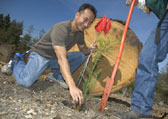
by Martin Snapp, Contra Costa Times
A week has gone by, but Erica Smith is still covered with poison oak.
Smith, a senior at UC Berkeley, is president of the Cal Forestry Club. Last week, she and other club members were crawling on their bellies through the underbrush in the Berkeley and Oakland hills, planting redwood seedlings. They were joined by volunteers from the Claremont Canyon Conservancy and ranger/naturalists from EBMUD, who were working on their own time.
They planted about 340 trees near Grizzly Peak Boulevard in Berkeley, another 750 trees in Oakland's Claremont Canyon.
It was the final stage of a two-year project to remove fire-prone non-native species, such as eucalyptus, Monterey pine and acacia, and replace them with more fire-resistant native species, including oaks, bays, big-leaf maples and redwoods.
The project is an unprecedented display of cooperation between two entities that are usually at loggerheads: UC Berkeley and neighborhood environmental groups. In addition, EBMUD is contributing logistical support, and East Bay Regional Park District fire tanker trucks will irrigate the seedlings for the next two years until they're able to survive on their own.
The first stage took place last year, when UC fire prevention workers tore out the non-native species, most of them eucalyptus trees. Even before the removal, members of the Claremont Canyon Conservancy were collecting indigenous seed stock to germinate the replacements.
The seeds -- about 11/2 pounds, enough to germinate thousands of trees -- were stored under carefully controlled temperature and humidity conditions at UC Davis until they were ready to be germinated at IFA Nurseries in McKinleyville.
Two weeks ago, Joe Engbeck, president of the Claremont Canyon Conservancy, got the phone call he'd been waiting for: "They're ready to go into the ground."
The seedlings are only 18 inches high, but redwoods grow quickly.
"Remember the redwoods that the Piedmont Rotary Club planted in Claremont Canyon in the 1970s?" said Tom Klatt, UC Berkeley's Manager of Emergency Preparedness, who has been the university's point man on the project. "They're already 60 to 80 feet tall."
Now comes the hard part: the waiting.
"Seedlings are very vulnerable at this stage," Engbeck said. "I'm worried about the weather we're having right now, especially the wind. It's blowing too hard for my babies."
As for Smith, her case of poison oak is still raging, but she doesn't mind.
"I'm used to itching constantly. It goes with being a forester. Besides, it's worth it to know that future generations will be able to go up there and enjoy these beautiful redwoods, just as I enjoy going to the UC Botanical Gardens or Founders Grove."
This story originally appeared here
